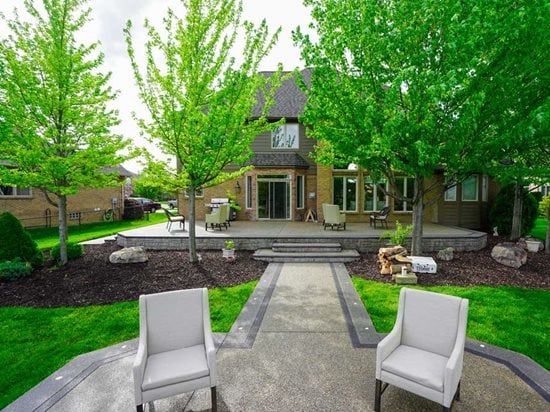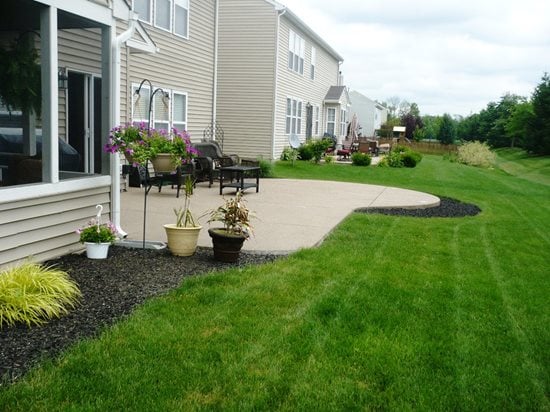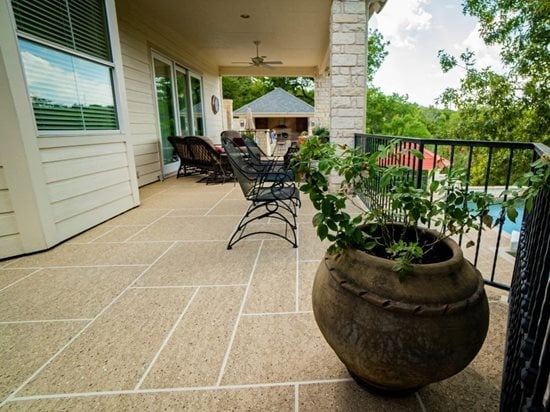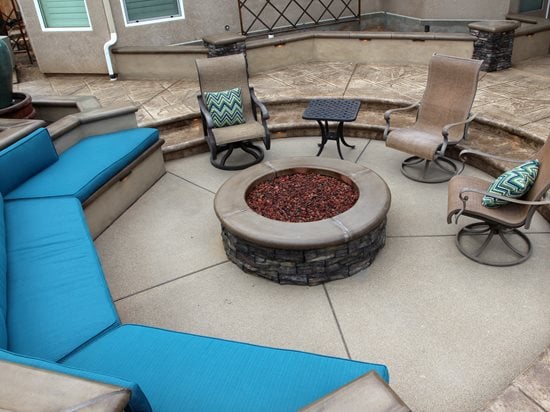
A tri-color exposed aggregate patio area extends out into the backyard via a walkway, providing a slip-resistant, attractive seating area. By Biondo Cement in Shelby Charter Township, MI.
Exposed aggregate is achieved by removing the top layer of cement paste to uncover the decorative aggregate within the concrete mix, creating a beautiful and slip-resistant surface. These qualities and more make it a great choice for patios.
Is exposed aggregate concrete good for a patio?
An exposed aggregate concrete patio is a great decorative concrete option for both residential and commercial properties. Here are some of the reasons people love it for outdoor hangout areas:
- Beautiful. The look of aggregate showing through create a gorgeous aesthetic, and you can customize the aggregate to meet your style needs.
- Safe. The aggregate creates a texture that creates a slip-resistant surface—making your space safer for guests.
- Hides flaws. Because the aggregate shows through, it creates a varied look, which hides small imperfections that are bound to occur on a concrete surface over time.
- Long-lasting. With the strength of concrete on its side, exposed aggregate is durable and resistant to damage from heavy foot traffic and various weather conditions.
- Reasonably priced. Though it’s slightly more expensive to install an exposed aggregate surface than a plain concrete surface, exposed aggregate is less expensive than other types of decorative concrete options such as stamping.

This exposed aggregate patio has a simple yet elegant finish—and its slip-resistant features make it a perfect spot for gathering with friends and family. By Concrete Tailors, LLC in Noblesville, IN.
Exposed aggregate patio pros and cons
As mentioned above, the pros of an exposed aggregate patio area are the aesthetics, slip resistance, hiding surface imperfections, durability, and reasonable cost.
Like anything, though, there are potential downsides. These aren’t necessarily deterrents, but rather things to keep in mind so you are well informed before making your decision:
- If food or drinks spill on your patio, it’s important to wash off your surface, no matter what type of decorative concrete you have—but you need to be diligent about washing off your exposed aggregate since there are nooks and crannies where you don’t want debris sitting.
- If you’re opting for larger aggregate pieces, you may find that you prefer a smooth surface for locations where you’ll be sliding chairs around. If you really want the larger aggregate, you may want to opt to use it only as a border rather than on the entire surface, designating a smoother area for seating.

This exposed aggregate patio mimics the look of tile but has the durability of concrete behind it. By SUNDEK of Austin in Round Rock, TX.
Is exposed aggregate more expensive than regular concrete?
Yes, installing an exposed aggregate surface is more expensive than installing a basic concrete surface. That’s because there’s additional labor required, and sometimes an additional product (such as a surface retarder) is also required. The decorative aggregate, which is added to the concrete mix, also creates an additional cost.
There are varying levels of expenses for exposed aggregate, and total cost can also be impacted by the type of aggregate used, as some are more expensive than others.
How long does an exposed aggregate patio last?
Because it has the strength of concrete behind it, exposed concrete surfaces are very durable. Even with lots of foot traffic, an exposed aggregate patio surface will last at least 50 years without needing to be repaired if you care for it properly. Appropriate care includes applying a sealer, which will protect it from things like oil spills, stains from standing water, and other contaminants.
How often you need to reapply sealer depends on where your surface is located and what type of wear it gets. If you are located in an area of the country where freezing occurs, you’ll want to reseal the surface as least every couple years.
Since the surface is textured, keeping it clean will also enhance the longevity of its appearance.

Here, a sunken, exposed aggregate fire pit area creates a clearly designated area for lounging and hanging out. By Heritage Bomanite in Fresno, CA.
See more photos of exposed aggregate installations here.
Exposed aggregate concrete patio ideas
Before choosing a design for your space, browse ideas online. There are many options when it comes to patio design that incorporated exposed aggregate, with styles sure to fit your needs. Here are some considerations to make when deciding on details:
- Aggregate size and shape. Sizes range from very small to large. For concrete patios, we recommend keeping the size of your decorative stones to 1/4 inch or smaller for maximum comfort. Shapes also vary. Rounded aggregates are best for patios because they’re more comfortable to walk on and provide better coverage than flat pieces or slivers.
- Aggregate color. Exposed aggregate colors vary from pastels to rich hues. In addition to choosing a specific color aggregate, you can opt to have the concrete itself colored using integral colors.
- Area of coverage. Do you want the entire patio to be exposed aggregate, or do you only want to expose the aggregate in certain sections or the border? This choice depends on your design preference.
Experienced concrete contractors can discuss options with you and help select the best choice for your space.